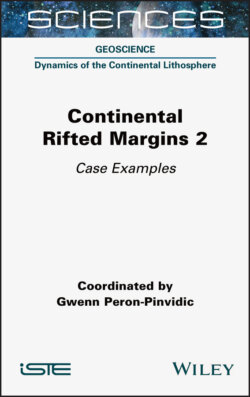Continental Rifted Margins 2

Реклама. ООО «ЛитРес», ИНН: 7719571260.
Оглавление
Gwenn Peron-Pinvidic. Continental Rifted Margins 2
Table of Contents
List of Illustrations
Guide
Pages
Continental Rifted Margins 2. Case Examples
Introduction
1. The West Iberian Margin: Past and Current Research Concepts and Future Challenges
1.1. Introduction: the West Iberian Margin, the “classic” magma-poor margin?
1.2. Structures of the West Iberian Margin
1.2.1. The Deep Galicia Margin (DGM)
1.2.2. The Southern Iberia Abyssal Plain (SIAP)
1.2.3. Conjugated West Iberian and Newfoundland Margins
1.3. Synrift tectono-stratigraphy and age and evolution of extension across the West Iberian Margin
1.4. Current models of development of the West Iberian Margin
1.5. Remaining questions at the West Iberian Margin and other magmapoor margins
Question 1: how is the crust thinned from 20 km to zero km?
Question 2: what is the role of detachments in rifting to breakup and how do they develop?
Question 3: what is the evolution of the lithospheric rheology, strain distribution, melt production and serpentinization during rifting?
1.6. Conclusions and outlook
1.7. References
2. Tectonic Evolution of the Mid-Norwegian Rifted Margin
2.1. Introduction
2.2. Large-scale structure
2.2.1. The proximal margin and the proximal breakaway complex
2.2.2. The necking domain and the necking breakaway complexes
2.2.3. The distal domain and the distal breakaway complex
2.2.4. The outer domain
2.3. Syn-rift basin configuration and evolution
2.4. Breakup
2.5. Post-rift evolution
2.6. Future challenges
2.7. Acknowledgments
2.8. References
3. South and Equatorial Atlantic Margins
3.1. Introduction
3.2. Geodynamics and understanding passive margins genesis
3.3. Crustal structures in the South Atlantic and equatorial margins
3.4. Conclusion
3.5. References
4. The Continental Margins of the Gulf of Aden
4.1. Introduction
4.2. Geological and geodynamic context and heritage
4.3. Continental rifting timing, initiation and depositional environments
4.4. Structure of the conjugate margins
4.5. Ocean-continent transition (OCT) and the birth of an oceanic ridge
4.6. Opening of the Gulf of Aden
4.7. References
5. The South China Sea – Rifting and the Evolution of a Marginal Basin
5.1. Introduction
5.2. Geodynamic setting and particularities
5.3. Propagators and implications on the rifting and the timing of breakup
5.3.1. Extreme thinning and detachment faulting away from narrow ocean–continent transition zones: far field and deep processes versus structural inheritance
5.4. A wide rift with boudinage crust resulting from contrasted crustal rheologies. 5.4.1. Hyperextended continental crust
5.4.2. Reactivation of the Mesozoic Granite Belt
5.5. Impact of the subduction and collision of the neighboring basin
5.6. Post rifting evolution; uplift of margins and delayed subsidence of the basin
5.7. Conclusion
5.8. Acknowledgements
5.9. References
6. Arctic Continental Margins
6.1. Introduction
6.2. Passive continental margins in the Arctic
6.2.1. The Canada Basin continental margins
6.2.2. The Eurasia Basin continental margins
6.3. Discussion and concluding remarks
6.4. References
7. Alpine Tethys Margins
7.1. Background and historical overview. 7.1.1. Preamble
7.1.2. Geological and paleogeographical settings
7.1.3. Historical overview
7.2. From dispersed outcrops to the 2D architecture of the Alpine Tethys rift system
7.2.1. Datasets and building blocks (BB)
7.2.2. Building a spatial and temporal template for the Alpine Tethys rifting
7.2.3. What is missing?
7.3. Evolution of the Alpine Tethys rift system
7.4. Continuous deformation vs. succession of distinct deformation phases
7.5. Three-dimensional aspect of the Alpine Tethys rift system
7.6. The Alpine Tethys remnants in the Alps: a laboratory to investigate and calibrate rift systems. 7.6.1. The role of rift-inheritance in building collisional orogens
7.6.2. Calibration of rifting processes
7.6.3. The benefit of data-based scientific debate
7.7. References
8. A Fossil Magma-rich Rifted Margin in the Scandinavian Caledonides
8.1. Introduction
8.2. Opening of the Iapetus Ocean and formation of the Central Iapetus Magmatic Province
8.2.1. The Seiland Igneous Province
8.2.2. The Scandinavian Dyke Complex
8.3. Discussion
8.4. Conclusion
8.5. Acknowledgments
8.6. References
9. Cretaceous Rifting at the Pyrenean Iberia–Eurasia Border: Crustal Thinning under a Pre-rift Cover – Application to Passive Margins
9.1. The North Pyrenean area within the Pyrenees
9.2. Mechanisms of crustal thinning deduced from the study of the NPZ
9.3. Crustal thinning at the Iberian–Eurasian plate boundary: smooth-slope basins and the legacy of Triassic paleogeography. 9.3.1. Cretaceous basins along the diffuse Iberian–Eurasian border
9.3.2. General characteristics of “smooth-slope” basins – consideration of continental crust thinning modes
9.3.3. The opposition between Pyrenean- and Alpine-type rifts: role of Triassic palaeogeography on the modes of crustal thinning
9.4. Conclusion: from the Pyrenean basins to the formation mechanisms of passive continental margins
9.5. Acknowledgments
9.6. References
List of Authors
Index. A, B, C
D, E, F
G, H, I
M, N
O, P, R
S, T, V
Summary of Volume 1
WILEY END USER LICENSE AGREEMENT
Отрывок из книги
Geoscience, Field Director – Yves Lagabrielle
.....
Cresswell, D.J.F. (2018). Continental break-up at the Galicia Margin. PhD thesis, University of Birmingham [Online]. Available at: http://etheses.bham.ac.uk/id/eprint/8712.
Davis, M. and Kusznir, N.J. (2004). Depth-dependent lithospheric stretching at rifted continental margins. In Proceedings of NSF Rifted Margins Theoretical Institute, Karner, G.D. (ed.). Columbia University Press, New York.
.....